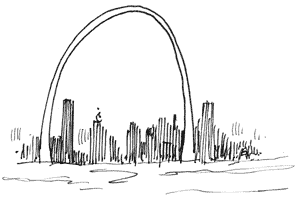Curvy: It's a catenary, not an arch

DRAWING BY DEBORAH DERR McCLINTOCK
Q. The breathtaking 630-foot-high 44,000-ton concrete and steel St. Louis Gateway Arch has a nifty curve. Is it a) a semicircle b) a parabola c) a catenary d) part of an ellipse? –M. van de Rohe
A. C, but make that an inverted catenary– like the droop of a rope hung loosely from pole to pole, then frozen and turned upside down. If you picked parabola, you're in good company, for Galileo himself mistakenly believed this. But it's a more special type of curve. Key fact about an inverted catenary like the Gateway Arch is that every point on it is in compression, making for an extremely strong and stable architectural structure.
Q. "Brain death" seems like a pretty modern concept. Where did the idea come from? –M. DeBakey
A. It was 1973, and the medical community was already unequivocal about the brain being "the seat of the soul," though the old idea of the heart as the source of emotion and intellect refused to die, says Mary Roach in Stiff: The Curious Lives of Human Cadavers.
Today we understand that the "heart keeps beating on its own not because the soul is in there but because it contains its own bioelectric power source, independent of the brain," Roach says.
Surgeons doing heart transplants know that once one is removed, it can continue beating for a minute or two without a blood supply, in fact can be dropped to the floor– as has happened– then washed off and it does just fine, says one New York doctor.
The surgeons in 1973 thus needed little convincing that irreversible coma should be the new criterion for death. But it took the lawyers a little longer. Then came accused killer Andrew Lyons, whose attorneys argued that since the victim's family had donated his heart for transplantation and the heart was still beating at the time of surgery, "then how could it be that Lyons had killed him the day before?"
Technically speaking, the organ recovery surgeon had killed the man, they contended.
The judge would have none of it, says Roach. Lyons was convicted of murder, and brain death eventually became the new legal definition of death in the U.S.
Q. It can symbolize the unknown, the uneducated, a hybrid plant in horticulture, magnification power in photography, 10, a male in genetics, dimensionality, a basic arithmetic function, burial place of a pirate hoard, making a political choice, a movie not suitable for kids, something not right, a location, kisses, Christ... though in general it has low occurrence frequency even while having more social and technical uses than any other letter in the English language. Have you guessed this mystery letter? –N. Webster
A. "X" is not wrong here, says David Crystal in The Cambridge Encyclopedia of the English Language. It stands for the unknown in algebra, Mr. X in an investigation, signature of the illiterate. X marks the spot on a map, it tucks into a 12x12 chessboard, 50x is a photographic magnification, Aceras x Herminium is a horticultural hybrid. And if you agree with all of these, put your X here!
Q. "I before E except after C." What thanks do school kids owe the originator of this famous mnemonic device for spelling words like "receive," "deceive," "conceive," "conceit," "ceiling"? –J. Brinkley
A. No thanks at all for this ancient, unscientific, inefficient, insufficient and deficient rule! Neither should kids try to rule-spell "financier," "society," "juicier," nor anything in the group of "eight," "beige," neighbor," "codeine," "protein," "reign," "seize," their," "weigh" and "weird."
There are well over 100 such exceptions, says Crystal again citing The Cambridge Encyclopedia of the English Language, with IE following C, or EI following just about anything it chooses. The only way to impose a degree of order on this muddle is to relate spellings to grammar and pronunciation, such as exceptions involving affixes (agencies, seeing, absenteeism) or proper names (Einstein, O'Neill, Leicester), or how the IE/EI is sounded, such as in an unstressed syllable of "ancient."
Send Strange questions to brothers Bill and Rich at .
#